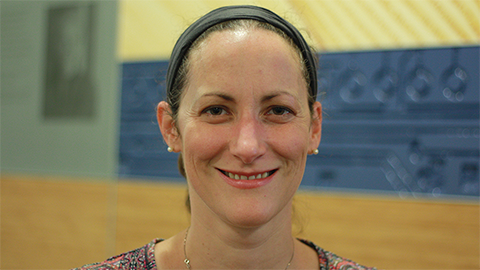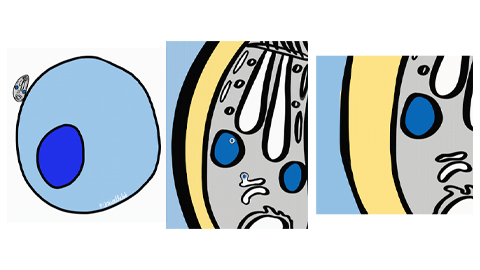Neuropharmacologist earns Tabor award
Maria Fe Lanfranco’s scientific career has crisscrossed the Western Hemisphere.
Born in Lima, Peru, she moved to the United States after college. “That was a big decision,” she said, “but … if I really wanted to pursue a career in science, I needed to do a Ph.D. outside Peru.” In the years since then, she has lived and worked all over the United States.

Lanfranco won a 2018 Journal of Biological Chemistry/Herbert Tabor Young Investigator Award for her work on allostery in an E. coli transcription factor carried out as a postdoc at Georgetown University.
With colleagues, she developed an approach to understand how communication across ligand binding sites affects this protein. She published the work in JBC in February 2017.
She credits her high school biology teacher with making it “almost a no-brainer” to study science in college.
“I’ve always been interested in identifying targets for the treatment of pathological disorders,” she said. Curiosity about the neuroscience of addiction drew Lanfranco to graduate work in the laboratory of Kathryn Cunningham at the University of Texas Medical Branch in Galveston, where she studied a serotonin receptor involved in cocaine addiction.
She followed her passion for understanding disease to a postdoctoral position studying signaling ethanol addiction with Dorit Ron at the University of California, San Francisco.
She lived in Berkeley and took a yoga teacher training course. “I started doing yoga because I was feeling stressed out — like every student in graduate school,” she said with a chuckle. A compelling teacher in Texas had gotten her more involved. In Berkeley, where she passed a yoga studio every few blocks, Lanfranco later began to teach classes herself.
With her husband, biophysicist Rodrigo Maillard, Lanfranco moved to Washington, D.C., to start his lab at Georgetown. The pair, both originally from Lima, had met in college and married as postdocs.
When Maillard started his lab, he pitched an allostery project to Lanfranco. She was interested in the neuropharmacology angle. To her, allosteric modulators are “a very provocative kind of drug, because it’s more interesting to modulate the activity of a receptor, rather than turning it on or off.”
After years of working in parallel, Lanfranco said, collaborating with Maillard works because “we complement each other a lot ... but we kind of set some rules in which we wouldn’t talk about work at home, because then it would be too much.”
Reflecting on her peripatetic pursuit of science, Lanfranco projects a yogic satisfaction: “All of those cities (Lima, Galveston, Berkeley and Washington) have a lot to offer … each one of them, at that particular time in my life, was the perfect place to be.”
Fusing monomers to understand allostery
Maria Fe Lanfranco and colleagues investigated how two identical subunits of an allosterically activated protein communicate about ligand binding.
The cyclic AMP receptor protein, or CRP, is a transcription factor activated through allostery, when binding of a ligand promotes a change in the protein’s characteristics at a distant site. CRP has negligible binding to DNA at first, but in complex with the small molecule cAMP, it binds DNA more strongly.
Like many allosterically activated proteins, CRP has two identical subunits. When one binds to cAMP, the other is more likely also to bind, a phenomenon known as cooperativity.
The team studied the intermediate stage, after one cAMP had bound but before the second. It was difficult to isolate this intermediate because it is short-lived and mutating the purified protein to disrupt cAMP binding results in dimers with the mutation in both subunits.
The researchers found a way to mutate just one subunit by cloning a linked pair of monomers. By adding asymmetric cAMP binding mutations to this molecule, they could capture the transient single-cAMP bound dimer more effectively. Binding of a single cAMP molecule was enough to open the DNA binding domain of the transcription factor, thus forming a stable DNA–protein complex.
Enjoy reading ASBMB Today?
Become a member to receive the print edition four times a year and the digital edition monthly.
Learn moreGet the latest from ASBMB Today
Enter your email address, and we’ll send you a weekly email with recent articles, interviews and more.
Latest in People
People highlights or most popular articles

Sketching, scribbling and scicomm
Graduate student Ari Paiz describes how her love of science and art blend to make her an effective science communicator.

Embrace your neurodivergence and flourish in college
This guide offers practical advice on setting yourself up for success — learn how to leverage campus resources, work with professors and embrace your strengths.

Survival tools for a neurodivergent brain in academia
Working in academia is hard, and being neurodivergent makes it harder. Here are a few tools that may help, from a Ph.D. student with ADHD.

Quieting the static: Building inclusive STEM classrooms
Christin Monroe, an assistant professor of chemistry at Landmark College, offers practical tips to help educators make their classrooms more accessible to neurodivergent scientists.

Hidden strengths of an autistic scientist
Navigating the world of scientific research as an autistic scientist comes with unique challenges —microaggressions, communication hurdles and the constant pressure to conform to social norms, postbaccalaureate student Taylor Stolberg writes.

Richard Silverman to speak at ASBMB 2025
Richard Silverman and Melissa Moore are the featured speakers at the ASBMB annual meeting to be held April 12-15 in Chicago.

